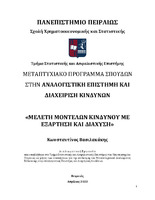Μελέτη μοντέλων κινδύνου με εξάρτηση και διάχυση

Master Thesis
Συγγραφέας
Βασιλακάκης, Κωνσταντίνος
Ημερομηνία
2023-04Επιβλέπων
Χατζηκωνσταντινίδης, ΕυστάθιοςΠροβολή/
Λέξεις κλειδιά
Φερεγγυότητα ; Θεωρία χρεοκοπίας ; Ruin theory ; Cramer Lundberg ; Sparre Andersen ; Ανανεωτικό μοντέλο ; Εξάρτηση ; Διάχυση ; Δυϊκό ; Gerber ShiuΠερίληψη
Για την μοντελοποίηση ενός ασφαλιστικού χαρτοφυλακίου, μία από τις πιο βασικές
παραμέτρους που θα πρέπει να ληφθεί υπόψη, είναι αυτό της φερεγγυότητας. Για να
χαρακτηρίσουμε ένα χαρτοφυλάκιο φερέγγυο, θα πρέπει ο ασφαλιστής να έχει επαρκή αποθέματα
για να είναι σε θέση να αποπληρώσει τις υποχρεώσεις του σε περίπτωση που εμφανιστεί κάποια
μεγάλη απαίτηση. Καθώς για κάθε ασφαλιστική επιχείριση αυτό διαφέρει, κάποιες φορές αυτό
ρυθμίζεται από κάποια ρυθμιστική αρχή που ορίζει την πιθανότητα αποπληρωμής των
υποχρεώσεων του ασφαλιστή (πχ 95%). Μια πολύ βασική έννοια στο ασφαλιστικό χαρτοφυλάκιο
είναι αυτή του ασφαλιστικού πλεονάσματος. Το ασφαλιστικό πλεόνασμα εκφράζει το κέρδος του
ασφαλιστή στη διάρκεια του χρόνου. Όταν το πλεόνασμα μηδενιστεί ή γίνει αρνητικό, τότε το
ενδεχόμενο αυτό ονομάζεται χρεοκοπία. Φυσικά και δεν αναφέρεται στο γεγονός ότι αν αυτό
συμβεί, τότε ο ασφαλιστής έχει χρεοκοπήσει, καθώς υπάρχουν διάφορες στρατηγικές που μπορεί
να ακολουθήσει ο ασφαλιστής ώστε να αντισταθμίσει την απώλεια (π.χ. capital injections).
Η θεωρία που μελετά το ενδεχόμενο της χρεοκοπίας ονομάζεται Θεωρία Χρεοκοπίας. Η
θεωρία χρεοκοπίας, με τη χρήση μαθηματικών εργαλείων, μελετάει το ενδεχόμενο η ασφαλιστική
επιχείριση να μην είναι ικανή να αποπληρώσει τις ασφαλιστικές της υποχρεώσεις σύμφωνα με
κάποιες παραδοχές. Η μελέτη δεν περιορίζεται μόνο στο ενδεχόμενο της αποπληρωμής των
υποχρεώσεών της, αλλά και σε επιπλέον «μέτρα χρεοκοπίας» τα οποία παρέχουν συγκεκριμένες
πληροφορίες για την πορεία και τη συμπεριφορά του ασφαλιστικού πλεονάσματος πριν και αφού
μηδενιστεί.
Οι πρώτες προσπάθειες για να μοντελοποιηθεί κατάλληλα το ασφαλιστικό πλεόνασμα,
έγιναν από τον αναλογιστή Filip Lundberg το 1903. Στην διδακτορική διατριβή που δημοσίευσε με
τίτλο: «Approximations of the Probability Function/Reinsurance of Collective Risks», εισήγαγε το
Κλασσικό Μοντέλο της Θεωρίας Χρεοκοπίας, το οποίο αργότερα ο Harald Cramér ενέταξε στις
στοχαστικές διαδικασίες. Το μοντέλο αυτό, θεωρείται εξαιρετικά πρωτοπόρο για την εποχή του,
καθώς δεν είχαν θεμελιωθεί ακόμα οι στοχαστικές διαδικασίες με τη σημερινή έννοια.
Από τότε, διάφορες γενικεύσεις αυτού του μοντέλου έχουν δημοσιευτεί κατά καιρούς, με τη
σημαντικότερη ίσως από αυτές να είναι το ανανεωτικό μοντέλο χρεοκοπίας που δημοσιεύτηκε το
1957 από τον Erik Sparre Andersen. Το μοντέλο του Erik Sparre Andersen γενικεύει την υπόθεση
σχετικά με την κατανομή των ενδιάμεσων χρόνων εμφάνισης των απαιτήσεων, κάτι που στην πράξη
εφαρμόζει αποτελεσματικότερα από την υπόθεση του μοντέλου του Lundberg.
Το 1997, στη δημοσίευση με τίτλο The joint distribution of the time of ruin, the surplus
immediately before ruin, and the deficit at ruin από τους Hans Gerber και Elias Shiu εισήγαγαν την
προεξοφλημένη συνάρτηση ποινής. Η τελευταία, έχει αποτελέσει εκτενές αντικείμενο μελέτης από
τους αναλογιστές για τις ασυνήθιστες ιδιότητες της και τις πληροφορίες που παρέχει σχετικά με
κάποια μέτρα χρεοκοπίας.
Στην παρούσα πτυχιακή εργασία, στο πρώτο κεφάλαιο, θα αναπτυχθούν οι βασικές έννοιες
για το κλασσικό και το ανανεωτικό μοντέλο χρεοκοπίας, και θα παραχθούν κάποια βασικά
αριθμητικά αποτελέσματα με τη χρήση της συνάρτησης προεξοφλημένης ποινής Gerber-Shiu. Στα
επόμενα κεφάλαια, θα μελετηθούν κάποιες από αυτές τις γενικεύσεις που έχουν προταθεί για το
ανανεωτικό μοντέλο χρεοκοπίας. Στο τελευταίο κεφάλαιο, θα μελετηθεί το δυϊκό μοντέλο
χρεοκοπίας, όπου ανταποκρίνεται κυρίως σε επιχειρήσεις και οργανισμούς που χαρακτηρίζονται
από συνεχή εκροή εξόδων και περιστασιακά έσοδα.

